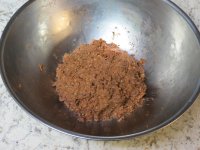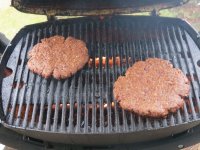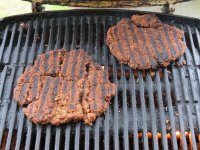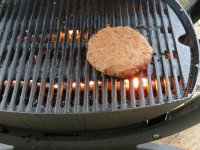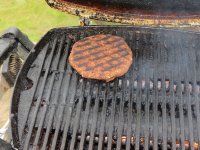Sure, best way to do it. And if possible with a pan with holes at its bottom, as alluded by nezbleu.Chestnuts roasting on an open fire?
Make a couple patties like you always do, making sure they are bigger than the bun to start and that they are skinny in the center so they end up flat when cooked. Put them on the grill. Flip them and realize your first mistake.
Hint to self: don't make them like you do regular burgers. They don't survive the flip.
Hint to self: don't make them like you do regular burgers. They don't survive the flip.
Attachments
Flavour: good
Resemble meat: no
Texture: no problem
Serve to your friends: yes, especially the vegetarians
Success: yes, I am glad
Improve it: no doubt
Clean the grill: Occasionally. I live in a wet climate, and that's an iron grill
Time for beer: yes, when is not a good time for a beer?
I think I will make some balls with the remainder.
Resemble meat: no
Texture: no problem
Serve to your friends: yes, especially the vegetarians
Success: yes, I am glad
Improve it: no doubt
Clean the grill: Occasionally. I live in a wet climate, and that's an iron grill
Time for beer: yes, when is not a good time for a beer?
I think I will make some balls with the remainder.
Last edited:
Cal, from what I understand one of the tricks with the new commercial Beyond Meat veggie burger that A&W are offering is beet juice. I quite like them myself - not that close to real beef/bison burger of course, but with appropriate condiments -including tomato and sliced pickle - they beat a Big Mac for my money. And as of the time of this writing, it’s almost (h)appy hour, so I’ll hoist a glass of Chardonnay in your name in, what about an hour?
In Eastern Aus, we have Moreton Bay Chestnut.
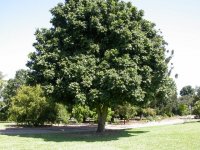
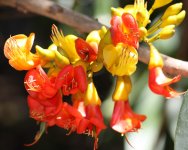
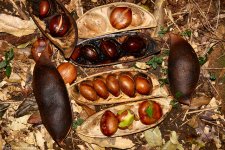
Austalian Aboriginals used these as a source of bread/damper flour, but only after leeching in a stream for several days -
Outside my school was a large tree that provided a great source of ammunition for after school 'wars'.
Dan.



Austalian Aboriginals used these as a source of bread/damper flour, but only after leeching in a stream for several days -
As kids we would crack open the pods and collect the seeds.The starchy seeds of this tree are poisonous, but were eaten by the aborigines after considerable preparation.
The Moreton Bay Chestnut seeds were cracked and soaked in water, then pounded , and made into cakes, and finally roasted. The washing in water removes some of the soluble toxins, while roasting destroys other toxins.
Outside my school was a large tree that provided a great source of ammunition for after school 'wars'.
Dan.
Sous Vide question?
I want to cook Filet Mignone for three people who prefer Medium rare, medium and "just order the chicken".
The temps are 135F, 140F and 155F.
Do I put all three in at 135 and cook two hours, remove the one and up to 140 for a half hour, remove one and up to 155 for a half hour, or reverse the sequence?
I want to cook Filet Mignone for three people who prefer Medium rare, medium and "just order the chicken".
The temps are 135F, 140F and 155F.
Do I put all three in at 135 and cook two hours, remove the one and up to 140 for a half hour, remove one and up to 155 for a half hour, or reverse the sequence?
130 is spot on medium rare. So probably shift your scale down by 5 degrees.
2 hours is a long time for this tender of meat as well; if the meat is at room temp and the water hot, I'd say an hour is where you want to be.
Are you planning to finish them in a screaming hot cast iron pan to get some crust? To get the gradient in temps for the respective eaters, I'd probably leave them in the pan for varying times to hit the right level of doneness. Med rare being on just about 30s a side (after letting it cool a bit from the 130 SV temp).
2 hours is a long time for this tender of meat as well; if the meat is at room temp and the water hot, I'd say an hour is where you want to be.
Are you planning to finish them in a screaming hot cast iron pan to get some crust? To get the gradient in temps for the respective eaters, I'd probably leave them in the pan for varying times to hit the right level of doneness. Med rare being on just about 30s a side (after letting it cool a bit from the 130 SV temp).
Filet is still coming from the tenderloin, and they're generally not *super* huge cuts of meat, so you should hit thermal equilibrium pretty quick versus a roast. I've done petite sirloins/NY strips/"steak" at 130F for around 45 min-1:30 and it's perfect medium rare color throughout the range. They just start getting a little mushy when you push out towards the longer times.
I have found this guide to be invaluable (and my experience corroborates almost 100% on the temp and time scales)
The Food Lab's Complete Guide to Sous Vide Steak | Serious Eats
(Thank goodness I'm still in the edit window!)
Let us know what you end up doing!
I have found this guide to be invaluable (and my experience corroborates almost 100% on the temp and time scales)
The Food Lab's Complete Guide to Sous Vide Steak | Serious Eats
(Thank goodness I'm still in the edit window!)
Let us know what you end up doing!
Last edited:
They just start getting a little mushy when you push out towards the longer times.
My take is the myoglobin color reaction is more temperature based and the tissue breakdown is both time and temperature based. So a chuck steak held at 130 for 18hr. is still pink and pretty much like butter. Unlike what you see everywhere the inside of the flesh of a properly slaughtered healthy animal is sterile and contains no blood (i.e. the red juice of rare meat is not blood).
Scott, that's pretty much it. The rate of collagen breakdown at 130 is pretty slow, but it's still going.
Oxtails/beef neck done super long at 130 is pretty fantastic and a flavor/texture experience worth at least one visit, but it's rapidly on its way to super-rich stew material.
Oxtails/beef neck done super long at 130 is pretty fantastic and a flavor/texture experience worth at least one visit, but it's rapidly on its way to super-rich stew material.
- Home
- Member Areas
- The Lounge
- The food thread
